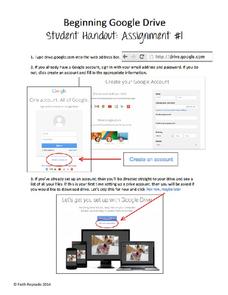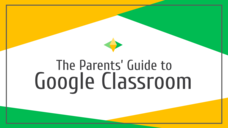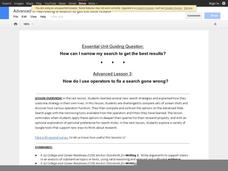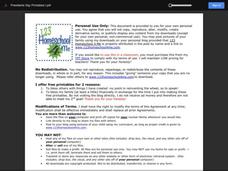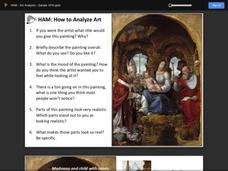Curated OER
Beginning Google Drive
Lead your class through creating and sharing documents with Google Drive with a step-by-step activity. The document illustrates each step with screenshots and includes clear and effective instructions that prompt active engagement....
Curated OER
The Parents' Guide to Google Classroom
Keeping abreast of how your child is doing in school can be a challenge. Never fear, help is here in the form of Google Classroom. Teachers use this platform to post assignments, check homework, and share newsletters with students and...
Curated OER
Google Earth Exercise: The Seven Wonders of the World
In this Google Earth worksheet, learners search the site and answer short answer questions about The Seven Wonders of the World. Students answer 28 questions.
Curated OER
Google Earth Exercise: Rivers
In this Google Earth worksheet, students search the site and answer short answer questions about different rivers in the world. Students answer 11 questions.
Curated OER
An Exploration on the Moon
In this Google Earth learning exercise, students search the site and answer short answer questions about the moon. Students answer 18 questions.
Teach Engineering
Projections and Coordinates: Turning a 3D Earth into Flatlands
Introduce your class to map projections and coordinates, the basics for the work done in a GIS, with an activity that uses Google Earth to challenge learners to think about the earth's shape.
Google
Advanced 3: Narrowing a Search to Get the Best Results
Familiarize your class with Google operators, specific symbols, or words they can use to express more clearly to the search tool what they want to find. With the resources included here, they can test their previous knowledge, view...
Smithsonian Institution
Dia de los Muertos: Honoring our Ancestors Through Community Celebration
Oral storytelling has been an important part of every culture. The time-honored practice uses stories as a conduit for a culture's values and customs from one generation to the next. Keep the tradition going with a family interview...
Statistics Education Web
First Day Statistics Activity—Grouping Qualitative Data
Making groups of groups can help to organize data. Classes use statistics to group themselves using descriptive adjectives. The objective is for learners to understand that grouping qualitative data is useful when the original groups are...
Mr. Roughton
Late Middle Ages Dossiers
Young detectives are given the "clues" to investigate whether King John should be remembered as a poor ruler of England, particularly in comparison in King Richard. They analyze historical informational texts and work in...
Curated OER
Peer Editing #2 for Expository Essay
Peer editing can be such an asset if it's done correctly! Help your kids provide constructive, meaningful feedback with this peer editing guide, designed for expository essays. The editor checks the format, introduction, body,...
Curated OER
Peer Editing for Expository Essay
You're class just finished writing an expository essay! Instead of having them do a self-edit, pair them up and give each person this guide. This is not your average peer editing checklist; it is a list of 35 things to look for in your...
Curated OER
"The Most Dangerous Game" Study Guide Packet
The comprehensive study guide packet for Richard Connell’s "The Most Dangerous Game" challenges young readers to reflect on hunting as a sport and what it means to be civilized. Using various graphic organizers, including a Cornell Notes...
Curated OER
Gerund Board Game
Play a board game that tests learners' knowledge of gerunds and promotes discussion. As players move along each square, they answer questions using a gerund.
123 Homeschool 4 Me
Presidents' Day Printables
Your youngsters will celebrate and commemorate some of the most prominent presidents in United States history with these fun worksheets. Activities include practicing writing quotes by the presidents, designing a new American coin,...
Inspired By Kindergarten
Numbers 1-10
Preschoolers and kindergartners can master numbers 1-10 with a set of math worksheets. Each page features one number that kids trace, represent with tally marks, and write what number they will have after adding or subtracting 1.
Mr. Roughton
Roman Empire
Does the United States parallel the Roman Empire in any way? Young historians work with four documents in order to answer this query as part of a structured DBQ assignment.
Mr. Roughton
Reformation Dossiers
If you were living during the Reformation and had to choose between arresting Henry VIII, Pope Leo X, or the Grand Inquisitor of the Catholic Church, who would you pick? This engaging assignment will have your young historians...
Mr. Roughton
The Geste of Robin Hood
This isn't your traditional Robin Hood tale! Explore a Middle English ballad with your young historians, and examine the underlying structure and purpose of historical texts.
Mr. Roughton
Chinese Dynasties
From the Q'in to the Ming, get the facts on the great Chinese dynasties from early history with these great handouts and worksheets. Presented in a Word document, they include the years the dynasties were in existence, the dynasty...
Mr. Roughton
The Travels of Marco Polo
Were the stories of Marco Polo's travels and interactions with the Mongols actually true? Using an excerpt from the book The Travels of Marco Polo, your young historians will answer guiding questions to discuss the accuracy and...
Mr. Roughton
How to Analyze Art
How does analyzing art differ from analyzing text? Young historians consider a piece of Italian Renaissance art and practice another type of primary source analysis through a close look and discussion of Bernardo Zenale's...
Biology Corner
DNA The Blueprint of Life
Engage learners with an intriguing presentation on DNA and its role in organisms. Individuals see its structure, what genes are, how the code works, and then explore DNA replication. For advanced classes, the presentation introduces...
Biology Corner
Human Genetics
Explore how our chromosomes work to define human attributes. A complete unit presentation includes topics such as genetic disorders, blood typing, and Punnet squares. Learners answer questions throughout the presentation to apply the...
